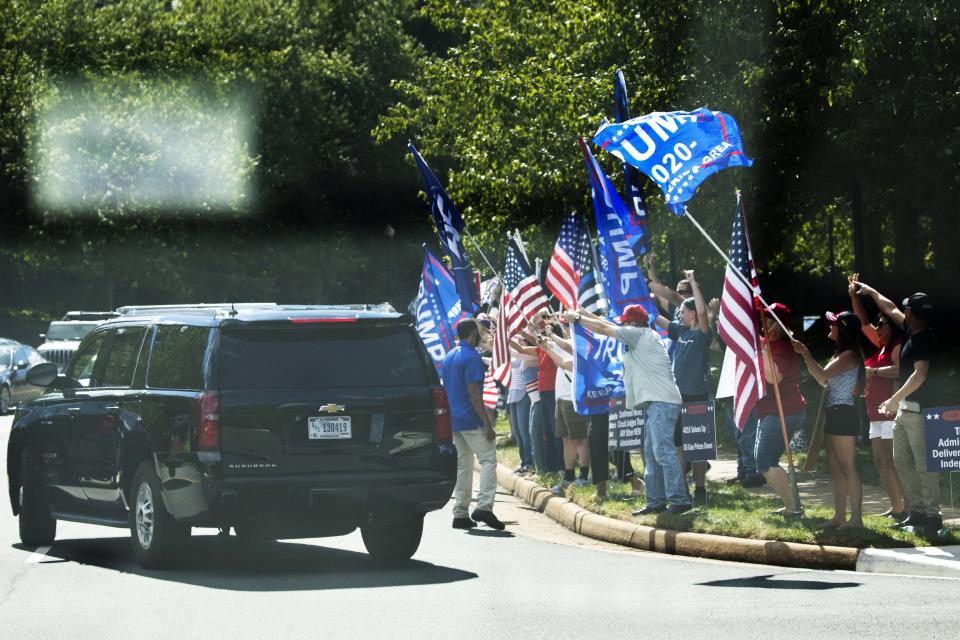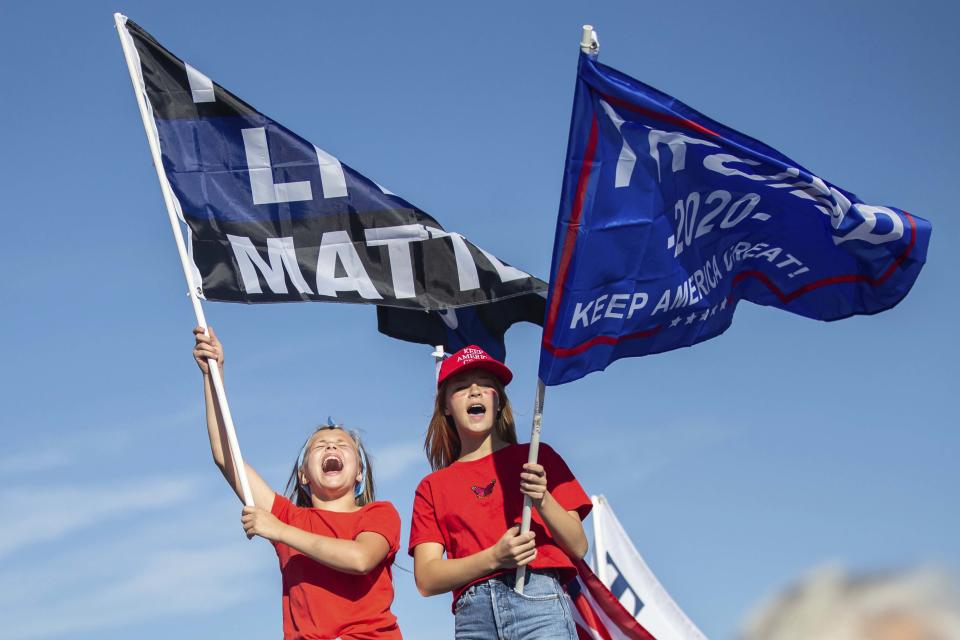The MAGA movement hits the streets — and Trump latches on
A take-to-the-streets MAGA movement that started online has become a reality, egged on by the oblique encouragement of President Donald Trump and little pushback from conservative leaders.
It’s a call to arms that has been bubbling online for weeks amid nationwide racial justice protests, circulating among white nationalist-affiliated groups and in local Facebook groups. Armed vigilantes have begun showing up, saying they were there to defend property and arguing Democrats had let lawlessness reign in the streets.
But the recent violent clashes in Portland and Kenosha, Wis., represent a turning point in the effort. In Portland, Trump supporters showed up as counterprotesters, and one of them ended up shot and killed. In Kenosha — where 17-year-old Kyle Rittenhouse was charged with killing two people — the clashes came to a smaller city, one that bridges the divide between major urban centers and suburban America.
It’s a development Trump and his team have latched onto as they try to win back much-needed suburban voters with a law-and-order message. Trump has branded the racial justice protesters “domestic terror,” praised the Trump-supporting counterprotesters, defended Rittenhouse’s actions and traveled to Kenosha on Tuesday to misleadingly take credit for stopping violence in the city and other urban areas. “It’s all Democrat, everything is Democrat, all of these problems are Democratic cities,” he told reporters during his tour.
The rhetoric is part of Trump’s two-track messaging as he heads into the final few months of the campaign. To his supporters, it’s an implication: I won’t condemn you if you show up. And to suburban voters, it’s a proclamation: The states have abdicated their duties, and only I can fix the violence that’s creeping closer.
“It is certainly true that there are plenty of conservatives who are growing ever more impatient with both Democrat-elected officials, who typically are at the state and local levels, and also with President Trump,” said Scott Walter, the president of the conservative-leaning Capital Research Center. “Because some of them see him as not acting as forcefully as he should.”
Since the resurgence of Black Lives Matter protests this year, Trump and his allies have ramped up not just their rhetoric about alleged lawlessness, looting and riots pervading American cities like Chicago, Seattle and Portland, but their actions as well, criticizing cities for rebuffing Trump’s overtures to deploy federal officials.
Trump’s offers have varied, from tweeting that he wanted to send federal forces into Seattle to dismantle the Capitol Hill Autonomous Zone, several square city blocks that were being occupied by anti-police demonstrators, to blasting Chicago Mayor Lori Lightfoot for supposedly resisting his help in policing gun violence in her city.
But some of Trump’s supporters have also taken it upon themselves to police these cities.

Though the narrative of American cities being overrun with violence has percolated through conservative media, it’s picked up in the past few years as anti-Trump, pro-BLM, and anti-police protests have snowballed. Scenes of looting, vandalism and property destruction only bolstered this worldview, and last year, right-wing extremists started clashing with antifa groups in Portland.
But after the killing of George Floyd in May, racial justice protests exploded across the country, with occasional instances of looting and vandalism. These destructive moments turbocharged the far-right calls to proactively defend private property that was being targeted.
While extremely few high-profile voices openly called for people to take to the streets and push back against protesters, there was an undercurrent of approval for those who did. Several videos emerged on the internet of police officers across the country chatting amiably with far-right militia members, often armed, during racial justice protests. Members of the Proud Boys, the main far-right group that brawled with antifa protesters in Portland last year, were spotted mingling with police union audience members during an appearance by Vice President Mike Pence earlier this summer.
And the St. Louis couple who went viral after a photo emerged of them waving guns at BLM protesters outside their house soon became MAGA superstars, getting a speaking slot at the Republican National Convention last week.
“How shocked are we that 17-year-olds with rifles decided they had to maintain order when no one else would?” Fox News host Tucker Carlson told his millions of viewers last week. His colleague Laura Ingraham on Tuesday asked why people were rushing to vilify Rittenhouse for exercising his “God-given right” to defend himself.
“If that’s the case, we are going to be in for a really, really long and protracted period of complete chaos and destruction which I don’t think the American people want,” she added.
From the beginning of the summer of protests, Trump, who won the endorsements of numerous law enforcement unions and interest groups in 2016, quickly embraced the protests as a culture wars issue, saying the words Black Lives Matter were a “symbol of hate” and calling racial justice protesters “looters” and “anarchists.” He has also accused Democratic rival Joe Biden of leading a party hellbent on destroying “LAW & ORDER” throughout the country.
And Trump’s refusal to condemn Rittenhouse, or to stop armed right-wing militia members from traveling to cities seeking out fights with BLM protesters, has only encouraged his fans.
The situation came to a head recently in Portland and Kenosha.
In Portland, the home of months of clashes between law enforcement and local protesters, an avowed antifa supporter allegedly shot and killed a member of Patriot Prayer, an independent group that had descended in a miles-long caravan on the city over the weekend in an attempt to show support for law enforcement and the president. On Thursday night, police shot and killed the primary suspect in that shooting as they attempted to arrest him.
And in Kenosha, there has been a rise of ad hoc, questionably legal militia groups such as the Kenosha Guard, a Facebook group heavily criticized for posting a “call to arms” against protesters on its page just days before the Rittenhouse shooting. In an interview with Kenosha News last Thursday, the group’s leader, Kevin Mathewson, stood by his belief that the “failure from local leaders” to secure their neighborhoods prompted him to make the post.

“This is what the Second Amendment was written for,” said Jack Posobiec, a pro-Trump correspondent with One America News Network and far-right internet personality. “We are at war in Kenosha. We are under siege. We are under attack. When law enforcement is outnumbered, that’s when citizens have the right to take up arms to defend their lives, their homes and their businesses.”
People have also been traveling into the city. The Justice Department on Thursday charged two Missouri men, Michael Karmo and Cody Smith, with firearms offenses after they were arrested with a massive cache of weapons. The pair allegedly went to the city to see Trump during a trip there Tuesday and “to see proof of the rioting,” according to a DOJ filing. Karmo also allegedly told a witness that he was going to possibly use the firearms on people in Kenosha.
Conservatives say unrest in Kenosha — a small Midwestern city with less than 100,000 residents — is likely to resonate more profoundly with suburbanites.
Posobiec pointed out that suburbanites had more affinity with their nearby mid-sized cities and, thus, would feel a stronger impact when seeing protests and property destruction in their own backyard.
“People move to the suburbs because they like living in a quieter area, but they also like to be close to an urban area, because they can then use that for work or going out shopping for entertainment, etc. And so they do feel a sense of connection to that urban area,” he said. “I can't speak for the people of Kenosha or that surrounding area, but I understand the mentality of somebody living in the suburbs of Kenosha wanting to defend Kenosha from riots.”
At this point, Walter said, the racial aspect of the BLM movement might not even play into the criticism of protesters anymore, pointing out that Trump seemed to have lost little support among Black voters.
“Probably that’s because some portion of Black folks who live in these places that are already harmed, or in danger of getting harmed, are getting disturbed,” he claimed.
A Quinnipiac poll released Wednesday showed Trump had 11 percent support among Black voters — slightly higher than the 7 percent he’d polled at in July.
Trump’s push to peg the violence to Democratic policy failures will likely continue into the final leg of the election — and absent a sustained campaign to condemn militia action, there is no impetus for his militia supporters to stop infiltrating American cities, either.
“It’s just crazy to think this is going on in the heartland,” said Posobiec. “If we're talking about Main Street, this is Main Street, USA being set on fire, and a political stalemate, and law enforcement at all levels wasn't responding.”

